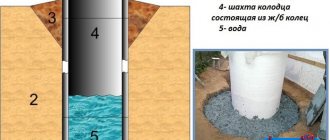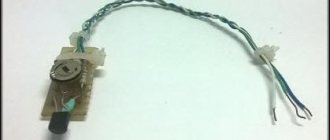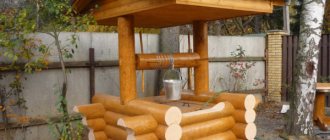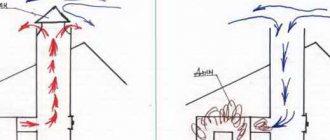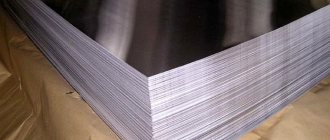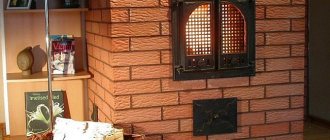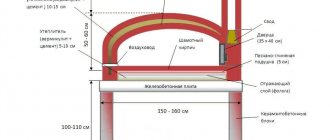More about clay castles
The aged plastic dough obtained by mixing clay with water acquires unique properties after compaction.
A thick layer of the laid mixture forms a waterproof screen that protects the foundation from groundwater and flooding. Oily clay is plastic, it gets wet slowly and takes a long time to dry. Its color has absolutely no meaning, so you should not pay attention to it. Proper preparation of the material for use will help to make reliable waterproofing. To do this, the clay is soaked, covered and left to sit for an indefinite time, making sure that it does not dry out.
Experts recommend preparing material in the fall and leaving it outdoors until spring. During this period, a cycle of gradual freezing and thawing of the clay occurs, which will facilitate uniform penetration of moisture through the interlayer spaces into all particles. The result is a homogeneous, plastic material suitable for use in a clay castle. To further improve the quality, lime is added to the waterproofing mixture, but not more than a fifth of the total volume.
The clay should not be over-moistened or over-dried. You can check the required humidity using a simple folk method. You need to take a handful of “real” rock, and then try to squeeze it in your fist. If the formed lump does not crumble and does not slip through your fingers, then the material is considered ready for use.
Clay does not deteriorate over time and requires virtually no material costs to purchase, since it is found almost everywhere in general use. A correctly made clay castle:
- does not require repairs - cracks do not spontaneously appear in it;
- not washed away by groundwater, but needs protection from storm drains;
- prevents the penetration of water, but allows moisture to pass to the foundation walls, and therefore it is recommended to additionally make surface waterproofing.
When constructing a clay castle, you should pay attention to the type of soil located in the area where the structure is being erected. If there is a sandy or sandy loam layer around the foundation, the expansion of clay during freezing will not play a big role
But for clay and loamy soil, an increase in the volume of the castle as a result of frost heaving can lead to unforeseen situations
In this case, it is important that the vertical surfaces of the foundation are smooth - without protrusions, recesses and expansions in the upper part of the structure. Otherwise, the buoyancy forces created by nature itself can lift the structure, squeezing the foundation upward
Procedure for carrying out work
If there is no opportunity or desire to use the services of a team of professional builders, all that remains is to make a clay castle for.
- Digging in. A trench is dug along the perimeter of the well to a depth of 150 - 180 cm. As a result, the second seam of the ring connection should be visible.
- All connections must be protected from clay getting into them. Any hydrophobic material that does not rot or decompose will do, for example, polyethylene film.
- Preparation of material. For a clay castle, it is allowed to take clay with a sand content of up to 15%, but the lower the figure, the better. If you follow all the recommendations, the clay is aged before use (usually left for the winter). To add strength to the castle, lime is mixed into the solution so that its content does not exceed 20% of the total mass of the mixture. The more sand there is in the clay, the more lime you need to add.
It is important that the clay is kneaded and not mixed. Previously, this operation was performed with feet, today they use small concrete mixers or use a drill with an attachment
The next step is to create a blind area on top of the castle. And without the recommendations of SanPiN, it is clear that after rains or melting snow, even a tightly compacted clay castle will turn into mud. The “soggy” top layer will get wet and dry, which will gradually lead to a loss of tightness. Therefore, the construction of a blind area is considered the logical completion of the process of creating a protective castle.
The covering material is selected based on personal preferences; both stone and paving slabs are suitable. And the creation technology does not seem complicated:
- the castle is covered with geotextile or other material with similar properties,
- The selected material is laid on top of the screed.
You can assemble a low formwork and fill the castle with cement mortar on top. The main thing is that the slope is maintained, because the task of the pavement is not just protection from moisture, but also its removal.
The construction of a clay castle will not affect the bacterial and chemical composition of the water on the site, but it will help keep it clear and suitable for consumption, if it was so initially. Therefore, in solving the dilemma “for” or “against” clay castles around the well, it is worth tipping the scales towards a positive answer.
Tips for use
- It is not advisable to equip them immediately after installing the well. It is better to let the soil settle for a year or more.
- When installing a soft blind area, it is better to use special waterproofing films.
- It is better to make a castle and blind area in late spring, when there are no longer frosts and the soil is still filled with water. In addition, during the spring and summer it will be clear whether the work was carried out correctly and whether it copes with water.
- The slope angle for a solid blind area is 2-5 degrees. For soft - 5-10.
- To install a concrete blind area, it is better to assemble wooden or metal formwork, and not just pour raw materials into a dug ditch. This will help give shape and neatness to the final product.
- After arranging the concrete blind area, you can build any decorative structure on the surface, for example, a gazebo with a roof.
Basic properties of clay structures
Clay belt - several compacted layers of clay.
The raw material has a natural ability to absorb and retain moisture, and a possible increase in volume of two or more times is noted.
A simple option for protecting a structure involves accessibility and low cost. The result is a clay strip that creates a strong protective barrier against ground moisture.
The principle of operation of properly installed protection
Additional insulation will need to be installed, otherwise the moisture from the clay will be in direct contact with the concrete.
The finished mixture may contain sand particles that reduce the original properties of the material. There is a change in clay size due to severe frosts. As a result of severe freezing of the protective lock, deformation of the building may occur.
The protective clay line allows you to protect the foundation from constant contact with soil moisture, regulates the outflow of water penetrating from precipitation, diverting it away from the foundation.
However, the structure will not protect underground premises.
How to make a clay castle: mastering the technology ↑
Clay of natural moisture is used to construct the castle. If it is removed from the ground for storage, it should be soaked by watering it and covering it on top. The clay is ready for use when it can be molded into something: it does not crumble and does not slip between the fingers when it is kneaded. It would not be superfluous to add 10-20% lime to the clay composition, especially if there is a high sand content in it.
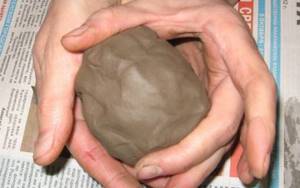
If the clay holds its shape: does not crumble or spread, it is ready for use.
The best results are obtained by carefully compacting the clay into the formwork. You can install wooden panels, ensuring the thickness of the castle is 15-20 cm. If the pit is not wide and there is sufficient material available, the walls of the pit themselves can serve as formwork. The clay is compacted in layers 20-30 cm high. Placing a geotextile fabric outside the castle will prevent its gradual erosion by groundwater. While there is no blind area, it is also worth laying a strip of geotextile around the perimeter of the house, making the backfill slope away from the building. The blind area can be made from a mixture of crushed stone and crushed clay, paved on top.

If the pit is not wide, the formwork may not be installed
The clay castle of the well is made similar to a blind area. It should be wide, at least a meter, and not necessarily deep, from half a meter. Better, of course, wider and deeper. If a water pipe runs from a well into a house, it must also be insulated with a lock, regardless of the depth of its installation. The clay can be covered with geotextile on top and paving slabs or cobblestones laid on it.
The clay pond castle is made 8-12 cm thick in three layers. The clay is kneaded to a soft dough, applied to a horizontal or inclined surface, compacted and allowed to dry a little. The surface should become similar in hardness to plasticine, then the next layer can be applied. During drying, including after finishing work, the clay should not be allowed to dry out to avoid cracks. It needs to be covered with film, or with hay. The pond will turn out ideal if you spread a pond film on top of the clay.
So, clay is not only a traditional, but also a promising material for waterproofing buildings from ground moisture. It is literally lying under your feet; the work does not require the performer to have qualifications or a complex instrument, although it is quite labor-intensive. European and American technologists continue to successfully develop new clay-based insulating materials; their appearance in Russia should be expected soon.
How to lay paving stones or paving slabs?
A blind area made of paving stones or paving slabs is especially durable and aesthetically pleasing. There are a variety of colors available to choose from, allowing you to choose the design you want. There is also a wide variety in shape: from simple geometric to intricate. The material is resistant to temperature changes, and therefore durable. The tiles are easy to remove and install back. They use simple installation technology. Geotextiles are spread over the sand of the soft blind area and sprinkled with a thin layer of dry cement. Place decorative elements. Lightly tap the mallet to level it out. Apply a rail to control the level: all tiles must be in the same plane. After completing the work, water the surface so that the cement sets.
How to make lubricant from clay?
To insulate and seal the ceiling of the cellar, clay lubricant is used. To prepare it, you can use any type of clay. Clay grease is prepared as follows:
- the clay is soaked for 2-3 days;
- to obtain 1 m3 of lubricant you need to take:
- 0.7 m3 clay dough;
- 0.28 m3 lime paste;
- 32 kg of fibrous impurities: chaff, firewood, straw cuttings 5-10 cm long;
- 200 kg of water, to which you can add copper sulfate at the rate of 100 g per 1 bucket;
All ingredients are thoroughly mixed and a clay lubricant is obtained for building a cellar with your own hands.
The video explains how to extract clay:
{lang: 'ru'}
Laying technology
The whole structure resembles a layer cake, where film is laid out first, then sand, and geotextiles on top (if it is necessary to block the germination of weeds) and decorative material.
Subsequence:
- The entire fertile layer of soil is removed (to the depth level of the second ring).
- The film is laid out so that one edge covers the ground near the wall (more than a meter), and the second is placed on the ring itself, covering the seam between the second and first ring.
- The film must be pressed against the well so that it does not slip. To do this, cut out a metal tape and wrap it around the wall of the first ring, pressing down the film. Fixed directly to the concrete with screws.
- You can simplify the task: secure it with tape by wrapping it around the ring several times. However, in the second case, you need to hide the pasting area under decorative material.
- A sand cushion is poured on top of the film with a slope away from the well and a decorative coating is laid out.
With this method, no heaving of the soil will tear the seam, because it is covered with a dense, loosely fitting film that can adapt to soil movements.
Features of waterproofing with a soft blind area
The use of temporary waterproofing in a soft blind area around a well has a number of technological aspects that must be taken into account during the installation process:
- The entire structure is laid at the level of the second ring.
- The materials used are waterproofing film and sand.
- The edges of the film strips are thrown over the well rings.
- Decorative material is laid on top of the film and sand.
In this case, all technological requirements must be met.
Laying technology
Before making a clay castle, you need to dig up the soil to the level of the 2nd ring. The selected soil is no longer used and must be removed and disposed of. A film is placed on the bottom. The size of the area to be closed is at least a meter from the outer wall of the reinforced concrete ring.
One end of the film is placed over the well above the seam. It needs to be secured, for which a metal belt, tape or self-tapping screws are used, which are screwed directly into the concrete. In the case where adhesive tape is used, several turns must be wound. After this, the cavity is filled with sand on top of the film.
Backfilling is not carried out to the very top if FEM or natural rubble stone is used as a decorative coating. When laying, check that there is a slope away from the well of at least 1.0-1.5 degrees. But this is a temporary method, and to ensure the tightness of the well, a clay castle is a necessity. But not every type of clay can be used as a material.
How to choose clay for a castle
To construct the castle, fatty varieties of red clay are used. The deposit doesn't matter. Another thing is the content of impurities. Clay is used that contains no more than 15% sand. Absolute purity is not required, but an excess of solid particles that cannot serve as a binder in an aqueous solution is a factor sufficient to reject the material.
If there is no fatty clay, and there is no place to bring it from, then you can use another type. During preparation, it is soaked and aged. Usually they work like in the old days: they are soaked in the fall and laid in the winter. At the same time, make sure that the clay does not dry out. So it becomes plastic, and all the particles combine into a single mass.
Periodic freezing and thawing is allowed during the soaking process. This is even good, since moisture permeates the entire volume. The main thing is to make sure that the mixture does not dry out or crack. And to improve plasticity, lime is added to the composition in a ratio of 1:5. For one share of lime put 5 shares of clay.
How to lay a soft blind area around a well + video
Some “experts” argue that this type of protection against water pollution is an atavism and a relic of the past. In fact, such statements are justified by two tricks:
- Few people say that you need to wait two years and then start improving the well. This is in order to put the source into operation as early as possible.
- It is beneficial for them that the client contacts them every year. After all, as a rule, the same people are engaged in cleaning wells from dirt, and it is beneficial for them that garbage appears in the water as early as possible.
The technology involves laying a film that covers the soil a meter around the walls of the well. The overlap that is placed over the seam between the first and second ring should cover it. The cavity obtained after excavation of the soil is filled with clay. It cannot simply be filled in and compacted mechanically. It is better to see the installation technology.
Conclusion + useful video
Summarizing all of the above, we determine that all the work associated with the installation of a clay castle can be done independently. Teams that claim that this is not necessary cannot be considered professional, or are being cunning in front of the customer. The described procedure is one of the mandatory measures for the improvement of natural drinking water sources.
The only thing that needs to be taken into account is that the clay castle is installed two years after the well is put into operation.
This means that in some cases decoration will have to be postponed. And within a two-year period, sand will be installed instead of clay. Otherwise, there are no difficulties, and the water in the well will remain clean and clear for years.
Blind area options
- Fill the clay castle with sand and gravel
. - Turf.
Layers of turf can be used as a blind area, but a prerequisite is the organization of a drainage system. - Tile.
Tiles are laid on top of the clay castle along the house. Having previously filled the base layer. - Concrete blind areas.
They are more expensive than the previous one and after a few years they will begin to let moisture through, even with additional reinforcement. Consequently, it will require replacement and additional costs.
To protect the foundation from destruction by groundwater and wastewater, you should organize a drainage system, build a clay castle and cover it with a blind area on top. If additional financial resources are available, it is possible to use additional waterproofing materials.
Foundations and walls of basements require mandatory waterproofing. Today there is a huge range of rolled and coating materials on the market, but once upon a time clay was traditionally used to protect the underground parts of structures from moisture penetration. Modern builders have not forgotten about clay castles built around the foundation, so the technology is still used to this day. But here we should not talk only about the Russian outback, since clay waterproofing is also popular in some European countries. The naturalness and high moisture resistance of the material ensure a fairly high demand for it, especially since the quality of clay castles has long been time-tested.
A brief excursion into history ↑
Until the mid-19th century, when constructing basements on moist soils, traditional and reliable technology was used: the foundation, made of brick or rubble with lime mortar, was coated with a layer of clay 8-10 cm thick, which was then covered with natural matting. A layer of crushed brick was poured from below as drainage, and when the soil was significantly moistened, drainage pipes were laid. Many European cities in regions with wet soil are built this way. In Russia, striking examples are St. Petersburg and Kaliningrad (Konigsberg), many of their basements are located below the groundwater level and remain dry. Systems of underground drainage and clay insulation were found by archaeologists during excavations of structures from the 14th century in Novgorod. Leaks in the basements of ancient buildings occur in cases where, when laying communications, current builders violate the ancient clay waterproofing and try to restore it using modern, familiar means.
Cob floors, which are still found in old country houses, remain completely dry even in humid climates until water is spilled on them from above. In rich ancient houses and churches, the floors were made of brick lining, with a clay layer 10-15 cm thick placed on top. The clay was carefully compacted with chains (threshed), poured with ox blood, tar water or slurry. The floor made in this way was covered with stone or ceramic tiles, again using clay solutions as glue.
In the 19th century, bitumen and tar began to be introduced into construction as waterproofing materials, gradually displacing traditional methods. In modern construction, mainly highly industrialized modern materials are used - waterproofing materials based on petroleum bitumen, cement and polymers. However, it is too early to write off clay in this capacity. Waterproofing structures with a clay castle is used quite widely to this day, not only in the Russian outback, but also in rich and advanced countries from a construction point of view.
Properties of a clay castle
The main properties and technical characteristics of a clay castle include the following:
- The construction of a clay castle does not require repair work and lasts a long time;
- Clay as a building material has a good ability to keep water out, but absorbs moisture, so the way out of this situation is to use an additional layer of waterproofing;
- Clay is a mineral material that does not deteriorate and has no shelf life, and due to its plasticity, cracks do not form in the clay layer;
- This building material is inexpensive, so the cost of arranging a clay castle for the foundation is minimal;
- Due to the ability of clay to expand in volume when freezing, it is necessary that the walls of the base of the house have a smooth surface.
Any type of clay with a minimum sand content is suitable for constructing a waterproofing layer made of clay. It is recommended to use fatty clay, in which the sand content is no more than 15%.

Sometimes, in order to increase the performance parameters of clay, lime is added to it in proportion to the total volume.
Advantages and disadvantages
The water seal not only prevents contamination of the source, but also protects the walls of the shaft from moisture, extending the service life of the structure.
The advantages of the protective structure are:
- High reliability and durability.
- Possibility of independent construction.
- No influence on the composition of water.
- There is no need to maintain fixed shaft seams every year.
- Availability of material.
The main disadvantage of the design is the labor intensity during construction. The difficulty lies in the need to comply with a number of features: an effective mechanism requires high-quality material and a high density of the protective layer. Otherwise, the castle will cause more damage. Disadvantages include the ability of the structure to collapse due to non-compliance with the shrinkage process and the possibility of deformation of the shaft due to freezing of clay.
How to do it yourself
Scheme of a clay castle for a well made of concrete blocks.
A clay castle for a well from concrete rings should be built after the soil around the hydraulic structure has settled and stabilized. The soil around the reinforced concrete rings is removed to a depth of about 2 m, the width of the pit is 1 m.
The bottom of the trench should slope away from the well walls and be narrower than its diameter at ground level. Before laying clay, the bottom of the trench must be covered with a small layer of sand or pebbles. It is permissible to lay sand on top of geotextiles - it will strengthen the bottom of the trench.
Before placing it in the pit, the clay mixture should be moistened and thoroughly kneaded until it becomes plastic. The optimal moisture content of the material for making a lock is 15-30%.
The prepared mixture is placed in a trench in a layer no more than 15-20 cm thick and intensively compacted. The layers are compacted with a heavy tool with a small sole area. They are laid out one after another until the surface of the castle is level with the surface of the ground. A roller is built around the well above the level of the castle so that rainwater flows away from the walls of the shaft.
Carefully compacted clay does not allow moisture to pass through, but its surface becomes viscous after rains. A nearby blind area or pebble layer around the well will help ensure ease of use of the source.
To prevent clay heaving from affecting the integrity of the well shaft, the concrete rings are wrapped in a layer of non-woven material. In this case, the soil near the walls will be able to move freely up or down without affecting the structure of the well.
Ensuring protection of well rings from displacement
In order to prevent any movement of the deck rings, it is necessary to install additional fasteners. To install additional fastening, you will need plates that are not subject to corrosion, as well as fasteners that are fixed in the supporting base and hold any structure (anchor bolts).
Stainless steel plates must be installed from the surface of the soil. It is necessary to complete the installation when you reach a height that is two hundred millimeters below the second seam.
The best option for this work is to use non-woven plastic materials, as they do not rot.
How to make a clay castle
The width of crumpled clay waterproofing depends on the depth of the foundation, and the size may be different for the upper and lower parts. With a standard depth of an underground structure of up to two meters, the width of the lock at the lower mark should be at least 40 cm, and at the top – at least 25 cm. Clay should be laid in pre-installed formwork in uniform layers of 5-10 cm with mandatory compaction of each layer. If the openings of the pit correspond to the size of the waterproofing lock, then the formwork can be abandoned.
The film will also be required upon completion of laying the clay waterproofing to the required level. The castle should be left covered for at least two weeks, after which it will be possible to begin constructing a blind area around the house.
The well was made for me by local craftsmen. Half of the wells in our SNT were dug by their hands. So I had a rough idea of what they were capable of, and I had neither the desire nor the time to look for someone on the side - autumn was coming, and I really didn’t want to leave the solution to this issue until next year.
It was clear in advance that there would be shortcomings, but I was ready to put up with this. One such defect was the absence of a clay castle. More precisely, what the workers did by filling the gap between the rings and the ground with clay could hardly be called a castle.
The main argument in favor of their technology sounded something like this: They’ve always done it this way, and everything was fine! They were not ready to create something more in line with the standards. Having come to terms with the situation, I decided not to argue, but to try to tackle the castle myself.
Clay castle. The construction of a clay castle is prescribed by the Sanitary Rules and Norms (SanPiN 21.4544-96, “Drinking water and water supply to populated areas”).
In paragraph 4.3.4. it says the following:
Along the perimeter of the well head there should be a castle made of well-pressed and thoroughly compacted clay or rich loam 2 meters deep and 1 meter wide, as well as a blind area of stone, brick, concrete or asphalt with a radius of at least 2 meters with a slope of 0.1 meters from the well towards the cuvette (tray).
The main function of such a lock is to protect the well from the penetration of surface water (the so-called high water) during rains and melting snow. Verkhodka is not purified by filtration through the soil and should not be used as drinking water. So I never had any doubts about the need for a lock. The question remained: how to do it?
Information on the topic obtained from available sources, primarily from the Internet, somewhat puzzled me. As it turned out, recently there have been many opponents of the construction of the castle.
They put forward as the main argument that in our climate, clay soils that find themselves in the freezing zone become very heaving—the soil that has frozen with the well trunk increases in volume.
This leads to rupture of the barrel, opening of the joints between the rings, and often to horizontal displacement of the rings. This happens almost every year, and in the end it becomes impossible to use the well - dirty water from the surface penetrates into it. That is, the castle not only fails to cope with the task, but also worsens the situation.
In Rus', a clay castle was used, for example, to protect cellars, cellars, and underground areas from water.
They also made a castle around the wells, and it did not seem to destroy the well itself. Why? This question remained not entirely clear to me, but one answer option more or less satisfied me. The fact is that in the old days wells were built in the form of wooden log houses. There were about a dozen interventional seams in the heaving zone, and when they opened evenly, each one accounted for only a few millimeters, which did not lead to depressurization of the well shaft. Today, most wells are made of concrete rings. The rings are most often connected to each other by a weak mortar seam, and in the heaving zone there is usually only one joint, which is not able to compensate for heaving deformations without being damaged.
To somehow reduce the risk of depressurization of the structure, there are various recommendations. For example, connect the rings more firmly (with steel plates, for example). But tightening the upper rings with metal pads, as a rule, does not help. The fact is that the forces acting during heaving are very significant and can deform even powerful fastening structures.
Other recommendations concern measures to reduce heaving forces. In this case, the well is considered as an unloaded foundation, and the same measures are applied to it as to foundations. Namely: replacing heaving soil around the well with non-heaving soil (essentially backfilling), insulating the soil and installing drainage around the well
Waterproof screen around the foundation
In the case of the foundation of a house, barn or other building, a clay castle will protect the concrete from exposure to water. As a result, the destruction of the base is reduced and the service life is extended.
As a rule, the depth of the foundation of a private house does not exceed two meters. In this case, the width of the clay screen should not be less than 40 cm. The height of the clay layer above the soil level is 25 cm, with a slope towards the house. The technology for laying the material is identical to working with a well or cellar.
If you plan to make a blind area in the future, this is possible two weeks after finishing work on the lock. This period of time is necessary for the top layer to dry completely.
